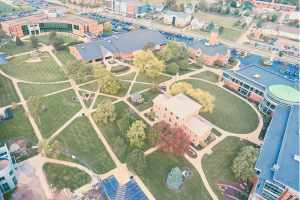
By Faith Farley, AACRAO Government Relations Intern
In preparation for the upcoming presidential election, students nationwide are mobilizing at higher education institutions to encourage their peers to get out and vote.
Individuals between the ages of 18 and 24 have historically had low voter turnout rates, with only 48% of eligible individuals voting in the 2020 election. This article explores how two higher education institutions in the District of Columbia, the George Washington University and American University, are helping their students' voices be heard at the ballot box in November.
Like most voter turnout campaigns, both schools’ efforts start with
student outreach, where classmates create informational materials about registering to vote and requesting absentee ballots. This also involves students talking to their peers about if they are already registered and if they have requested an absentee ballot. At George Washington University, students from different organizations on campus have been speaking with students about their voting plans and sharing media surrounding the importance of voting, regardless of party affiliation. In recent years, social media has become a critical tool for reaching younger voters, with many school-affiliated accounts sharing information about voter registration deadlines and how to request an absentee ballot.
Higher education institutions’ student-run newspapers have been another essential tool for sharing information. For instance,
American University’s (AU) student newspaper, “The Eagle,” reported on student initiatives encouraging the campus community to request absentee ballots and register to vote. One initiative in particular, held at Bender Library on AU’s campus, resulted in 917 students requesting their absentee ballots. These news outlets keep students informed about events surrounding the upcoming election, and they can highlight volunteer opportunities for students.
Many higher education institutions have established student-led task forces that foster an environment of civic engagement in the
public policy process through volunteering and activism. For example,
George Washington University established GW Votes in collaboration with the Nashman Center, their volunteer and community involvement office, to plan on-campus events surrounding voter engagement. These events include inviting guest speakers for panel discussions surrounding the upcoming election, sending out newsletters, and tabling to aid students looking to request absentee ballots or register to vote.
One distinct way that institutions can promote civic engagement on their campuses is by canceling classes on election day. Both American University and George Washington University have canceled their classes on election day, November 5, which eliminates barriers that could prevent students from voting. These are just a few of the ways that higher education institutions can raise awareness about elections and the policies being debated, and increase voter turnout for a population that historically needs just a little extra push to become engaged.
The most crucial message in this article is simple: VOTE. Make sure you’re registered to vote and that your information is up to date, such as your address and last name. And finally, have a voting plan. This means that if you’re voting in person, know where your local polling place is and allow yourself enough time to vote. If you’re voting via mail, then make sure you follow your local deadlines, as these vary by state.
Vote.gov is a great resource that can help you get started with all of this.